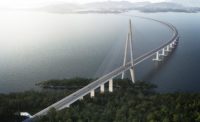After awarding a turnkey contract for the world's longest bridge in 2005 and canceling it a year later, the Italian government is again reviving the idea of building a road and rail crossing between Sicily and the mainland.
At 3,300 meters, or more than 10,800 ft, the suspension bridge’s main span would be nearly 1,300 m longer than Turkey's current world record holder, the 1915Çanakkale Bridge.
Last month, Italy's Council of Ministers adopted a decree to revive the project company Stretto di Messina S.p.A., with the aim of securing approval for the executive design by July 2024.
The project "is a top priority" for deputy prime minister and infrastructure minster Matteo Salvini, according to a government statement.
On April 19, Pat Cox, a European Union coordinator for regional transportation corridors, offered to share costs of updating environmental impact studies for the crossing.
Testifying to a parliamentary hearing this week, the engineering director of the contractor Webuild S.p.A., Michele Longo, said the bridge could be built at a cost of $4.9 billion in six years after eight months of executive design.
"As soon as the contract is reinstated and updated, the project can start," Longo said.
Then led by Italy's largest contractor Impregilo S.p.A., the Eurolink joint venture won the bridge's design-build project in 2005. Eurolink also included Japan's Ishigawajima-Harima Heavy Industries, Co. Ltd., Tokyo, with Denmark’s Cowi A/S, Lyngby, acting as lead designer. Following a merger and name change, Impregilo became Webuild S.p.A.
 The proposed design would feature the world's longest suspension bridge main span. Rendering courtesy of Stretto di Messina S.p.A.
The proposed design would feature the world's longest suspension bridge main span. Rendering courtesy of Stretto di Messina S.p.A.
Design work on the bridge resumed in 2009 but stopped again two years later. Renewed hopes for the project grew in 2016 when Webuild accepted an informal challenge to build the the bridge by Italy's then-prime minister, Matteo Renzi. But "we are still trying to get the government to pay the penalty for having annulled the contract,” said a contractor's spokesman at the time.
With three vehicle lanes in each direction and one for a rail, the deck would provide a 600-m-wide navigation channel with 65.6 m of headroom, according to Longo. The aerodynamic profile would withstand 300 km-per-hour winds and also survive 7.5 Richter earthquakes.




Post a comment to this article
Report Abusive Comment